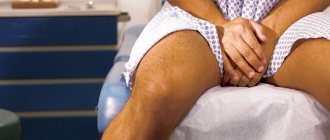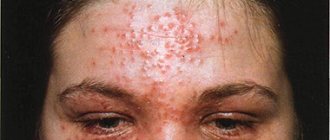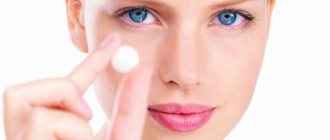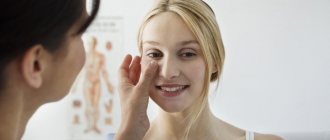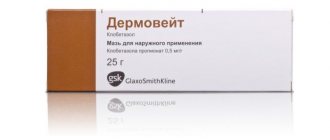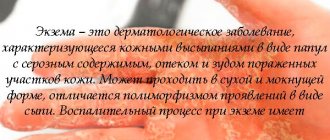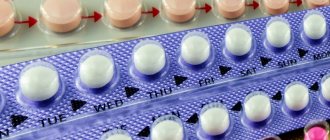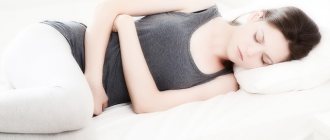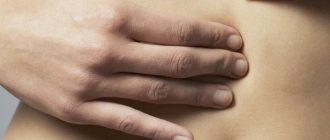Skin affected by eczema may produce less oil and oil than healthy skin. If this happens, the skin will retain less moisture, causing gaps to form between skin cells. These crevices make it easier for bacteria and irritants to enter and cause problems.
Some debate whether this condition is separate from eczema, which occurs in other parts of the body. For example, one 2013 article argues that it should be classified separately.
Scrotal eczema has some of the same symptoms as eczema found in other parts of the body. In this article, we will look at these symptoms and steps to treat and cure them.
Causes of eczema in the groin
The main cause of the disease remains a mystery to specialists; many theories have been put forward about what causes the symptoms, what complicates the disease, and what factors accelerate the disease process. But all doctors agree on one thing - the disease is multifactorial, that is, it appears not for one reason, but for two or more, which has been proven by multiple studies. Most often, patients experience increased symptoms upon contact with allergens, which indicates the allergic nature of the disease.
There are many theories about the cause of eczema. They are divided into the following types:
Internal factors:
- The hereditary theory is confirmed by the fact that in 75% of cases when the father and mother have eczema, a child is born with the same disease.
- Disruption of the endocrine system and improper production of hormones in the blood. For example, with obesity and diabetes, the secretion of the sebaceous glands is disrupted and this leads to the appearance of symptoms.
- Many patients noticed that after stress, symptoms intensify. This may also be the cause of the disease.
- Diseases of organs and their systems: gastrointestinal tract, central nervous system, cardiovascular.
- Poor metabolism and immune defense.
External factors:
- Inappropriate medications, allergic reaction to the composition of antibiotics and other drugs.
- Allergies to chemicals such as household chemicals, skin and hair care products, cosmetics.
- Bad ecology.
Find out more
Eczema on the genitals - causes of the disease, main symptoms and treatment
This disease affects both male and female genitalia. They are characterized in their own way, have their own characteristics in distribution, symptoms and therapy. If you contact specialists in time, many complications can be avoided.
This disease always begins quickly: symptoms appear almost instantly. The labia majora area will be affected first. The main symptom is a rash in the form of blisters with vesicular fluid.
With a strong impact on the affected areas, they open and leave weeping areas. The skin swells, which makes it possible to differentiate genital eczema from other diseases of this type that provoke itching. Damaged skin areas on the genitals may become inflamed, causing swelling and redness.
A characteristic feature of genital eczema is that, unlike its other types on the body, arms, legs or head, the patient’s main complaint will be painful discomfort. The pain can be very severe and associated with a burning sensation.
Causes
Before talking about the reasons for the formation of the disease, it should be noted that genital eczema is not a threat to other people; the infection will not spread from infected skin to healthy skin. The non-contagious nature of the disease has nothing to do with the patient’s sexual partners.
The reason often lies in contraception: personal intolerance to latex products, allergies to fragrances and lubricants are popular triggers of the disease. The reasons that lead to the formation of genital eczema are external and internal.
External ones are:
- the use of personal hygiene that irritate the skin of the genitals;
- wearing synthetic and too tight clothing;
- allergies to specific substances;
- prolonged use of antibiotics;
- prolonged depression, constant stressful situations.
Internal factors are:
- diseases of the gastrointestinal tract;
- functional disorders of the endocrine and nervous system;
- deterioration of the immune system;
- genetic predisposition.
Genital eczema is often the result of various disorders within the human body or the unfavorable influence of hygiene items and clothing. In view of this, it would be optimal to first identify the source of the disease and focus on its elimination.
Causes and symptoms
Athlete's foot in the groin area, or Hebra's eczema, is a skin pathology caused by the spread of a fungal infection (pathogen: Epidermophyton floccosum). In addition, the development of the disease is facilitated by a number of factors depending on the general condition of the body and the person’s lifestyle.
Eczema Hebra is observed in the area of large folds:
- inguinal-femoral area;
- intergluteal zone;
- under the breasts (in women);
- armpits.
Most often, the pathology affects the groin area. The disease mainly manifests itself in the warm season or in countries with a hot climate. Doctors note that skin rashes in the groin occur more often in men than in women.
Factors contributing to the occurrence and development of fungal infection:
- mechanical damage to skin tissue (intimate hair removal);
- long-term diaper rash;
- disruption of the endocrine system;
- diabetes;
- excess body weight;
- sweating;
- wearing tight clothes;
- insufficient hygiene;
- poor circulation in the legs and groin area.
Symptoms
The acute form of such pathogenesis will significantly affect the quality of life of patients, in particular, sexual life. During exacerbations of eczema, sexual contact causes pain to those suffering from this disease.
Characteristic laboratory signs are eczematous lesions on the skin in intimate places. Genital eczema in women develops in several stages, appearing first on the labia majora, then covering the pubis, clitoris and labia minora. When there is no proper treatment, symptoms can include the folds of the thighs, perineum and anus.
It is not known for certain about the risk of spreading genital eczema to the internal genital organs. There are known cases of progression of the disease and its infection of the uterus and vagina.
An neglected disease will become chronic. When provoking circumstances appear, exacerbation can occur up to 3-5 times during the calendar year.
The main symptoms of genital eczema in women:
- At the erythematous stage, you may notice redness, swelling and itching of the skin, which causes significant discomfort.
- The formation of papules, which turn into vesicles with exudative fluid, represents the next stage of disease progression.
- Then the blisters on the labia burst , forming a weeping hole.
- The crust stage is the stage of regression of genital eczema.
- The covering of damaged areas on the genitals in women with yellow-gray surfaces is a harbinger of healing of the upper layer of skin.
- Peeling of crusts and skin restoration begins
All about the causes and treatment of eczema on the legs
- Inna Viktorovna Zhikhoreva
- September 25, 2020
The entire pathogenesis is associated with pain near the genitals. Eczema in the groin in women occurs in a similar way to dermatosis on other parts of the body. The severity of the disease is determined by the specificity of its concentration. Itching and burning may worsen at night.
Genital eczema in the groin in men is often concentrated near the scrotum rather than on the penis. Severe swelling of the testicles and changes in size are the most popular symptom in males, forcing them to focus on their well-being. Such manifestations are characteristic of the erythematous stage of the disease.
Source: https://estetica16.ru/dermatit/pahovaya-ekzema-u-muzhchin.html
Symptoms of eczema in the groin
The symptoms do not so much undermine the patient’s physical health as their psychological health, since during intimate relations a person experiences pain, the genitals itch, itch, redness and other symptoms appear on them.
Symptoms of eczema between the legs differ between women and men. But according to statistics, this pathology is more common in men. Symptoms should be treated immediately for both sexes; you should contact experienced specialists to relieve discomfort and restore sexual life.
Traditional medicine recipes
In men, the disease can be treated using “grandmother’s” methods. Here are some recipes.
- Birch buds. A strong decoction of this raw material is taken and used as a compress for affected areas. As a result, the inflammation will be relieved and the itching will stop.
- Yarrow in infusion form. The product is used to carry out internal therapy measures. You need to take 2 tablespoons of the original raw material, add 1 glass of water that has passed the boiling stage into it, drink 1/3 of the resulting container 3 times a day.
- Rose hip. An ointment of gruel and cream is used, which must be smeared on the blisters in order to reduce their redness.
Eczema in the groin in women
In women with inguinal eczema, itching appears in the labia area and on the inner thigh, the skin swells, and turns red. Papules with liquid form on the labia minora and majora, which soon burst and weep. Wet areas dry out, forming crusts on the skin.
When treated, the crusts become yellowish, which is a good sign. They peel off from the skin, the symptoms are relieved.
To find out how eczema manifests itself in the groin in women and what symptoms it is accompanied by, look at the photo.
Prevention methods
For preventive purposes against relapses of genital eczema, it is recommended:
- balance the diet and saturate the diet with vitamins, saturate it with natural and healthy food;
- lead a healthy lifestyle, engage in moderate physical activity;
- get rid of bad habits;
- treat all chronic diseases in a timely manner;
- carefully choose sexual partners, avoiding sexual intercourse without contraception;
- underwear should be made of natural fabric;
- For intimate hygiene, use only those products that have a neutral pH.
- Dmitry Pavlovich Tkachenko
- July 11, 2020
When the rash has already appeared on the body, in order to alleviate the patient’s condition, it is necessary to carry out the following actions:
- take a shower after any physical activity that is accompanied by excessive sweating;
- treat the rash with talcum powder or baby powder;
- wear comfortable underwear, made from natural material and fully appropriate to the patient’s size;
- wash regularly, which helps prevent the spread of pathogenesis to healthy skin.
The above measures help prevent the disease, and if it has already manifested itself, speedy healing.
Self-treatment of genital eczema is prohibited. Before using medications, you should find out your doctor's recommendations.
Despite the fact that the disease does not require mandatory therapy in a hospital setting, if complications arise, complex treatment under the supervision of specialists cannot be avoided. Genital eczema can be quickly treated, but only if you consult a doctor in a timely manner and follow all his instructions.
0Share0Share0Share0Share0Share0Share
To avoid the appearance of sores in the anus and groin area, you must follow certain rules:
- balanced diet,
- maintaining physical fitness,
- sports,
- walks in the air,
- hardening,
- getting rid of underlying diseases,
- prevention of depression, stress,
- wear comfortable underwear,
- compliance with hygiene rules.
Thus, the condition of eczema is not a death sentence. If you follow medical tips and recommendations, you will get rid of it forever.
To prevent the development of Hebra eczema you need to:
- maintain personal hygiene,
- change bed and underwear in a timely manner,
- do not share towels and other personal hygiene products,
- increase the number of water procedures during the hot period,
- control weight.
The best prevention of fungal and bacterial infections is caution in public swimming pools, saunas, and gyms.
Eczema in the groin in men
With eczema in the groin in men, symptoms appear on the testicles, penis, scrotum, pubis, glans, the symptoms remain general, you can view a photo of it, and your doctor will tell you how to treat it.
Symptoms differ depending on the stage of the disease. Eczema appears in men in the area of the scrotal folds, on the hips, and pubis. The first symptom is characterized by the formation of red spots in the intimate area. Most often, they first form on the testicular area and gradually spread to the penis. The area of the testicles swells and they increase in size. Rashes and papules appear, which open faster in the genital area than in other locations. The affected areas itch, and when the papules are opened, pain appears.
The disease gradually spreads throughout the genital organs. The entire area turns red, and when the head is affected, fluid secreted from the bursting papules collects under the foreskin.
The chronic stage of eczema is distinguished by its severity, as the skin on the genitals thickens, it cracks, and the skin flakes off. This affects the emotional state of the patient, since pain and itching cause constant discomfort. If a bacterial or fungal infection gets into the wounds, complications arise
Symptoms
First of all, it is worth noting that the skin manifestations of inguinal eczema are significantly different from other eczematous rashes.
The disease begins with a feeling of discomfort in the groin area, which intensifies during periods of physical activity. As the disease develops, the unpleasant sensations are accompanied by bright pink spots, limited by a red ridge. A few days after the spots appear, the skin inside the roller dries out and begins to peel off profusely.
Subsequently, if the patient does not receive proper treatment, the rashes merge with each other, affecting large areas of the skin and spreading throughout the body. Moreover, often on flaky spots a wound surface appears, covered with serous fluid, which leads to constant weeping and further complicates therapy.
In addition to skin rashes, patients experience:
- itching;
- burning;
- soreness;
- swelling.
Genital eczema can spread to the following areas:
- pubic;
- male genitals and scrotum;
- woman's labia.
Eczema bordered, developing on the pubis, in the vast majority of cases is acute in nature, however, occasionally it can become chronic. The main symptoms of this form are swelling of the skin and fluid-filled blisters that quickly open and dry out.
Eczema of the genital organ and scrotum is accompanied by the appearance of blisters, swelling and redness of the genitals, the formation of erosions and severe weeping.
Eczema on the labia is manifested by the appearance of blisters, severe itching, erosion of the mucous membranes and skin, and the appearance of peeling.
Treatment of eczema in the groin
When the first symptoms appear, you should immediately contact a dermatologist, he will tell you how to treat groin eczema.
Treatment of groin eczema in men and women should be read in a timely manner. If treatment is not started in time, complications may arise that will be very difficult to cope with. And if the papules begin to open and the area is not treated with an antiseptic, a fungal or bacterial infection may occur.
First, the doctor will diagnose the disease. The doctor sends him for tests, but many experienced doctors can accurately diagnose only with a visual examination. The patient undergoes allergy tests to identify substances to which he is allergic.
A biopsy is performed in cases where it is not possible to accurately determine the diagnosis. And based on the test results, the medicine and its dosage are selected. The use of drugs in combination will improve their effectiveness. With it, symptoms can go away in 10-15 days.
The doctor prescribes antifungal medications and antihistamines to relieve an allergic reaction. In the chronic stage, since conventional drugs no longer help, hormonal drugs are prescribed. Under no circumstances should you choose your own medications, especially hormonal ones, and use them not according to the instructions. This can worsen the course of the disease and lead to complications.
An additional diet is also prescribed that excludes any allergens from the diet. It is forbidden to eat fried, smoked, salted, spicy food, strong tea and coffee, eggs, honey. You should eat steamed food and drink at least two liters of water a day. It is recommended to observe the rules of genital hygiene, use medications strictly according to the indicated dosage and regularly.
Treatment of eczema in the groin with folk remedies
Folk remedies used to effectively relieve the symptoms of eczema, but now modern drugs cope with this task much better. There are many cheap and safe products that have undergone clinical trials and are absolutely safe for health, so they should be given preference. However, traditional methods are often used even in complex therapy. They are most effective at the beginning of the disease, and they also improve the effect of conventional drugs.
There are many methods for treating eczema in the groin using traditional recipes. For example, compresses are prepared from birch buds or white vinegar to relieve inflammation and itching; yarrow, chamomile, St. John's wort and eucalyptus are often used as tinctures to treat illness from the inside; A cream is made from rose hips and the affected areas are treated with it; oak bark, string, flax are used for lotions.
Physiotherapy
In the primary stage, the disease can be cured at home, after first consulting with a treating specialist. But if the pathology has progressed and moved to further phases, inpatient therapy will be required under the supervision of an experienced dermatologist to avoid complications. All activities can be classified into two areas - medicinal and folk. All of them are relevant and can easily complement each other.
This group helps to reduce the manifestations of allergies on the genital organs, as well as reduce the condition of itching and severe burning. If the symptoms are severe, in order to improve the condition, it is recommended to additionally take sedatives for a quality night's rest. The most common composition is Gistan, Bepanten, Lorinden, Zodak, Tavegil, Suprastin, Fenistil.
Treatment of wounds in the anus is the first step towards healing. To do this, it is recommended to use special antiseptic agents for external use that relieve the inflammatory process. In practice, doctors most often prescribe iodine 2%, silver nitrate in the form of a solution, Furacilin, Betadine.
If the inflammatory process develops extremely quickly and rapidly, it is necessary to use anti-inflammatory compounds. They are aimed at relieving inflammation and helping to improve the general condition and quickly eliminate vesicles, pustules, and papules. In modern medicine, the drug most often prescribed is Dexamethasone according to a doctor’s prescription, as well as Citeal, Kategel.
If an infection of a bacterial nature is added to the overall picture, it is recommended to consume antibacterial agents - antibiotic drugs. They improve the general condition of the genitals and help cope with many symptoms and signs. Most often, experts prescribe Erythromycin, Tetracycline, Doxycycline, Loprax.
In the process of scratching wounds, the lion's share of patients encounter a disruption of the normal nervous background. Therefore, in order to avoid damage to the nervous system, it is necessary to take a complex of sedative compounds - Glycine, Novo-passit, Persen, Sonmil.
Hormonal ointments
If the disease has progressed to a more complex stage of progression and has begun to be accompanied by the formation of ulcerative areas and exudative-type rashes, there is a possibility that it will be necessary to take hormonal ointments and tablets. The most common drugs for Herb's disease are Triderm, Dermovate, Carizon.
Further therapy, when the main symptoms of the disease have gone, is carried out exclusively using the antifungal composition. The most commonly used cream is Ketoconazole and Exoderil. In addition, you can take and use an ointment containing salicylic acid, tar, and a sulfur component.
Anal eczema can also be treated through physical therapy. She rehabilitates patients. The following therapeutic areas are most often used in practice:
- balneotherapy,
- thalassotherapy,
- ozone treatment,
- laser disease removal,
- use of liquid nitrogen,
- electrophoresis,
- magnets,
- UV treatment,
- electrosleep.
All these tactics will help you reduce itching and pain in the genitals and anal area, and also feel better.
To treat eczema on the legs near the groin, traditional and traditional medicine methods are used. To cure the disease, it is necessary to destroy the fungal colony and restore the integrity of the epidermis.
In cases of impaired immune defense or functioning of the endocrine system, it is recommended to undergo additional therapy to eliminate the causes of the pathology. A low level of immunity contributes to the development of bacterial, fungal and viral flora both inside the body and on human skin.
We suggest that you familiarize yourself with Eczema on the hands between the fingers, treatment. Causes of eczema on the fingers and its treatment
You need to start treatment immediately after detecting the first signs of eczema. At the onset of the disease, ointments and gels for topical use are helpful, and for the treatment of advanced forms, a course of systemic medications is prescribed: Itraconazole, Terbinafine. The duration of the course and dosage of medications is prescribed by the attending physician, taking into account the general condition of the patient, the stage of the disease and the list of contraindications.
In advanced cases, for the treatment of large areas of affected skin, it is recommended:
- use of 10% potassium chloride solution (intravenous administration),
- taking antiallergic drugs (Diphenhydramine, Tavegil, Fenkarol),
- the use of specialized antibiotic and antifungal drugs,
- vitamin complexes.
In addition to taking medications internally, the patient must use external agents:
- Fukortsin,
- Boron-naphthalan ointment,
- Ethacridine (under a bandage),
- Furacilin,
- Undecine ointment,
- Sulfur-salicylic ointment,
- Decamine ointment.
Dressings and lotions help prolong the therapeutic effect of ointments, but you must remember to replace them in a timely manner.
The most popular antifungal drugs include:
- Lamisil,
- Clotrimazole,
- Mycoseptin,
- Nystatin,
- Triderm,
- Nizoral.
If side effects or signs of allergy occur, the patient should consult a specialist to prescribe an analogue of the drug.
Folk remedies are used during the period of remission of skin diseases, for prevention or as an addition to the main elements of treatment.
- Mix equal parts chopped small-leaved basil and centipede larch. For 3 tablespoons of the mixture you will need 0.5 liters of boiling water. Leave until the color is rich and add 1 glass of strained liquid to the water while taking a bath. The average duration of the procedure is 20 minutes, the bath is repeated up to 12 times. The water should be warm, since prolonged hot baths can negatively affect the functioning of the heart.
- Combine equal parts of dried St. John's wort, lingonberry leaves, horsetail, medicinal chamomile, yarrow, violet and eucalyptus. Three tablespoons of the dry mixture must be poured with boiling water (600-700 ml). Let the infusion stand for an hour and filter. Take a third of a glass orally up to 3 times a day, the course of treatment is 14 days.
- Mix equal quantities of dry rue, fenugreek and cinquefoil roots. For 2 tablespoons of dry mixture you will need 300 ml of boiling water. Leave in a dark place for an hour, strain. The product is used for lotions or added during bathing.
Before starting the course, you should make sure that there is no individual intolerance to the components of the herbal mixture.
Prevention of eczema in the groin
To prevent complications during the treatment of eczema in the groin and prevent the disease, the following preventive measures should be taken into account:
- Follow a special diet for eczema, take vitamins B, A, D, E, C, drink at least 2 liters of water per day, follow a daily routine.
- Experience light physical activity.
- Do not come into contact with substances that cause allergies and other allergens, such as household chemicals, unnatural cosmetics, low-quality clothing and shoes.
- Maintain genital hygiene.
- If symptoms or complications appear, consult a doctor for diagnosis/medication.
- Do not self-medicate to improve the quality of treatment.
Diagnostics
If you experience itching in the scrotum or penis, you should immediately consult a doctor. The specialist will visually examine the affected areas, conduct proper diagnostics and recommend effective therapy. Only after diagnosis is it possible to begin treatment of unpleasant symptoms.
When genital eczema is left without proper treatment, its form develops into a severe form, which can cause severe discomfort for men. Thanks to diagnosis, genital eczema is differentiated from various sexually transmitted diseases.
We invite you to familiarize yourself with How to register a disability group for a cancer patient
Also important during the examination is the detection of allergens that caused pathogenesis. Microbiological diagnostic methods, which make it possible to identify the virus and determine its susceptibility to antibiotics, are prescribed to patients with suspected development of microbial eczema.
- Igor Ivanovich Semenov
- July 24, 2020
Often, when establishing the nature of the disease, complex allergological and immunological diagnostics are carried out.
A timely examination will make it possible to carry out adequate therapy, after which there will be no trace of redness and rashes. It would be optimal to conduct a comprehensive diagnosis.
This is necessary in order to establish the causes that provoked the onset of the disease. Only this approach contributes to successful healing from genital eczema and prevents it from becoming chronic.
Treatment of the pathology begins after determining the form of eczema and the cause of its appearance.
Diagnosis of inguinal athlete's foot includes:
- scraping from the skin affected by the rash,
- microscopy,
- bacterial culture using Sabouraud's medium.
After conducting tests and identifying possible internal disorders in the body, the dermatologist prescribes the necessary therapeutic measures and a course of medications.
Intertriginous dermatitis
The term intertriginous dermatitis comes from the Latin word intertriginis, translated meaning abrasion, irritation, and in the medical sense diaper rash.
This is a dermatological disease caused mainly by mechanical damage to the skin.
Affected areas
Diaper rash occurs primarily in skin folds, where friction and increased sweating are constantly present. In this case, the epidermis becomes thinner and damaged. The most common foci of the disease are:
- Buttocks and intergluteal region.
It occurs not only in infants, but also in adults, especially in the summer, in hot and humid weather, which increases sweating.
Most often, folds on the neck occur in children and obese people.
This is a very common localization of diaper rash, as any person is most susceptible to hypohidrosis.
The lesion occurs on the feet in the interdigital area and under the knees. A secondary fungal infection may occur.
Diaper rash is usually located between the fingers and on the elbow.
Dermatitis appears in the folds of the abdomen and umbilical area. May arise from constant exposure to the epidermis. For example, when wearing a belt.
The genital area is very vulnerable to diaper rash because it is most susceptible to friction and moisture.
Diaper rash behind the ears does not occur very often, as a rule, in children who use hats made of synthetic materials and are overheated.
Diaper rash symptoms
This type of dermatitis has a specific clinical picture, which depends on the stage of the disease. Common symptoms include:
- Redness of the skin (so-called erythrema). Appears in the early stages of diaper rash. It usually has a symmetrical shape and is located on both sides of the skin folds.
- Swelling of the skin at the site of redness of the epidermis.
- The appearance of microcracks and cracks in the affected area.
- Itching and burning sensation. Occurs due to irritation of nerve fibers in the affected area.
- An increase in humidity at the site of diaper rash formation, so-called exudation.
- The appearance of infiltrates - bubble formations filled with liquid
- The appearance of eczema in the later stages, peeling.
There are three degrees of the disease:
There is slight redness, the integrity of the skin is not compromised.
Cracks and ulcers appear at the site of the lesion.
Severe inflammatory process, the appearance of eczema, possibly a fungal or bacterial infection.
Diaper rash in babies
In children, diaper rash most often occurs between the legs, on the buttocks, under the arms, and in the ear area. Infantile dermatitis is associated with several factors.
- Unformed thermoregulation of the body leads to rapid overheating, and the child begins to sweat. It is necessary to monitor the temperature in the room so that the baby's skin is dry.
- Too much humidity in the room, combined with wrapping yourself up, also contributes to the production of sweat.
- Using a diaper results in the baby's skin being constantly exposed to waste products from the body. In this case, poor hygiene can lead not only to an inflammatory process, but also to the addition of a bacterial infection. A low-quality diaper that does not allow air to pass through and is made of hard material can cause chafing and diaper rash.
- Diaper rash can be caused by an allergic reaction, so it is necessary to carefully monitor the diet of mother and baby.
Treatment of mild diaper rash in children involves more careful skin care, hygiene procedures using infusions of string, chamomile, oak bark or a solution of potassium permanganate. In case of a more severe stage of the disease, it is necessary to consult a pediatrician, since it requires the use of special healing ointments.
Diaper rash in women
In women, areas under the mammary glands, in the folds of the abdomen, in the neck and genital area are often affected. The causes may be:
- Hormonal changes. A woman’s body experiences stress during the menstrual cycle, pregnancy, lactation and menopause. In this regard, the composition of skin secretions changes, sweating increases, which provokes the appearance of diaper rash.
- Vaginal discharge and urinary incontinence, which are common in women, can cause intertriginous dermatitis in the genital area. At this moment, humidity in the genital area increases, to which pathogenic microflora joins.
- Very often, diaper rash occurs in overweight people, since obesity promotes increased secretion of subcutaneous sebum and sweat.
In addition to enhancing hygiene, herbal infusions can be used to treat dermatitis. To soften the affected area, you can use baby cream. You should pay attention to the quality of clothing, it must be breathable
If these measures do not help, you should consult a dermatologist. It is possible that the reasons lie in the presence of a more severe disease that caused diaper rash.
Diaper rash in men
In men, the skin around the reproductive organs, under the arms, and on the legs most often suffers. The disease can be caused by:
- Metabolic disorders and associated increased sweating.
- Diaper rash around the genitals may indicate the presence of a sexually transmitted disease.
- Poor or irregular hygiene, especially in overweight people, leads to the proliferation of streptococci, staphylococci, and Candida fungi on the skin, which contribute to the appearance of diaper rash.
- The disease can be provoked by tight clothing and uncomfortable synthetic underwear that does not allow air to pass through.
In addition to standard methods of combating the disease, aimed at drying and softening the skin, a dermatologist may prescribe antibiotics or hormonal ointment, depending on the cause of diaper rash.
Diaper rash in older people
In older people, diaper rash most often affects the groin, armpits, palms, and feet. This is one of the categories most susceptible to the occurrence of the disease.
- Age-related changes contribute to the sharp decrease in the formation of collagen, elastin, and hyaluronic acid. The skin ceases to be elastic, becomes thinner, and becomes dry. Due to this, they are more susceptible to injury and cracks.
- Often, older people suffer from diseases that can provoke dermatitis: diabetes mellitus, hemorrhoids, vegetative-vascular dystonia, endocrine diseases, kidney dysfunction.
- The disease often affects bedridden patients, including due to lack of hygiene procedures. The clinical picture may be aggravated by the use of adult diapers.
Elderly people with this disease should definitely undergo examination by a specialist. Their skin is not capable of rapid regeneration and does not heal well, so the use of special ointments is required.
The occurrence of intertriginous dermatitis can be easily prevented by preventive measures. First of all, careful regular hygiene is necessary. In addition, you need to monitor your diet and weight. Wearing breathable clothing made from natural fabrics can also prevent illness.
Source: //dermatolog03.ru/dermatit/vidyderm/intertriginoznyj-dermatit.html
Seborrheic dermatitis on the scalp and sebaceous glands
The skin is covered unevenly with sebaceous glands; there can be from 4 to 380 ducts per 1 cm2. They lie in the middle layer of the skin - the dermis, between its papillary and reticular layers. The largest number of sebaceous glands are located in the so-called “seborrheic zones”: on the skin of the face and body (back, neck, scalp, pubis, chest, abdomen, shoulders, forearms, legs). There are no sebaceous glands on the skin of the soles and palms.
For the most part, the ducts of the sebaceous glands open at the mouths of the hair follicles. In smaller numbers, the excretory ducts open directly onto the surface of the epidermis - in the area of the eyelids, borders of the lips, external auditory canal, nipple halos, and anus.
The size of the glands and the amount of lipid secretion depends on various factors: the functioning of the endocrine, nervous, reproductive systems of the body, age. In young children, the sebaceous glands secrete very little secretion. By adolescence, their work increases sharply, but as they grow older, their activity decreases.
Athlete's disease of large folds: features of the course and effectiveness of treatment
In all countries of the world, superficial mycoses of the skin (SMS) are an urgent interdisciplinary problem. They are registered in 20% of the world's population [1]. Dermatophytosis predominates among MVP, affecting 10% of the population [2, 3]. Dermatophytosis takes second place in the structure of morbidity after pyoderma [3].
The predominance of the incidence of skin mycoses in large cities makes it possible to call them “diseases of civilization” [4, 5]. Analysis of the results of the Achilles project (1988-1997)
), in which several European countries and Russia took part, showed that 35% of patients who consulted a dermatologist had one or another mycosis [6–8]. Dermatophytosis of the feet, compared to other localizations taken together, is recorded 3 times more often [9, 10].
Much less attention is paid to mycoses affecting large folds [9, 11—14]. However, mycoses of large folds (MCF) are a significant interdisciplinary problem in medicine.
Analysis of the incidence of the population of Russia on the ISS is practically impossible. What is this connected with? In the ICD-10 classification there is only athlete's foot (B35.6). The traditional approach to MCS, which existed before the introduction of this classification into practice, included athlete's foot, rubromycosis and candidiasis of large folds.
Each of the nosological forms has its own epidemiological and clinical features, a range of trigger factors that influence the course and chronicity of the process and, naturally, features of the choice of treatment tactics [2-4, 15-17].
Many years of experience in the system of postgraduate professional education have shown that dermatologists currently register rubromycosis of large folds in the section “Other dermatophytosis” (B35.8), and candidiasis of large folds - in the section “Candidosis of other localizations” (B37.8).
Sometimes, among mycoses of large folds, only rubromycosis of the inguinal-femoral region and candidiasis of large folds are distinguished [18].
Inguinal dermatophytosis is a collective term that unites largely clinically similar skin lesions caused by various pathogenic and opportunistic fungi.
It has even been proposed to distinguish the following variants of inguinal dermatophytosis (dermatomycosis): epidermophyton inguinal ( Epidermophyton floccosum
), inguinal rubrophytosis (
Trichophyton rubrum
), inguinal dermatomycosis (
Trichophyton mentagrophytes var.
interdigitale), candidiasis of the groin area (yeast-like fungi of the genus Candida
), mold mycosis of the groin area (
Aspergillus
spp
., Scopulariopsis brevicaulis
) and mixed dermaphytic-candidiasis or dermaphytic-mold mycosis of the groin area [11, 12].
This is explained by the fact that the etiological basis for the diagnosis is important for treatment, since not all topical antifungal drugs are equally effective against various pathogens of mycoses. However, candidiasis and mold mycosis do not belong to dermatophytosis and this classification has not found application in practical mycology.
It is important to note that specialists studying the problem of skin mycoses, citing the classification of dermatophytosis according to ICD-10, indicate nearby the previously accepted synonym/equivalent of the disease. With inguinal athlete's foot, in particular, two nosological forms of the disease are synonymous/equivalent. These include epidermophytosis and rubrophytosis of large folds [19].
The cause of inguinal dermatophytosis is various pathogens, which are recorded unequally often: Epidermophyton floccosum
- in 35-40% of cases;
Trichophyton mentagrophytes var.
interdigitale - 20-25%;
Trichophyton rubrum
- in 15-20% [1, 11, 12].
Candidal mold fungi, as an independent etiological factor in damage to large folds, are detected in 3-5% of cases [1, 9, 11, 20].
However, verification of mycoses pathogens is not carried out in most dermatological institutions, not to mention city clinics and somatic hospitals of related specialties.
A number of authors include lesions of the pubic region, caused by zoophilic trichophytons, as inguinal epidermophytosis. Thus, over a 10-year period in the Andijan region of Uzbekistan, during an examination of 2022 patients with trichophytosis, lesions in the pubic area were detected in 248 (12.3%) cases [21]. When examining 286 patients with a similar pathology, a spectrum of pathogens was established.
In 97.7% of cases it was Tr . verrucosum
, in 2.3% -
Tr .
mentagrophytes var. gypseum . Clinically, an infiltrative-suppurative form of trichophytosis was detected in 62.2% of patients [22]. In these publications there are no indications of damage to the inguinal folds. On the other hand, in 2005
with zooanthroponotic microsporia in 4 women, mycosis was localized in the pubic region, spreading to the inguinal folds and inner thighs [23]. The results of studies carried out in the Republic of Kyrgyzstan indicate that in case of inguinal dermatophytosis, various pathogens were more often sown: Tr .
verrucosum
(52.2%),
Tr .
rubrum
(25%),
Epidermophyton floccosum
(20.6%),
M. canis
(2.2%) [24].
It is significant that the author describes clinical variants of damage to the inguinal folds. The superficial-spotty variant predominated in cases of infection with Epidermophyton floccosum
(76%), infiltrative (85.7%) and infiltrative-suppurative (67.9%) - in cases of
Tr
.
verrucosum
.
When isolating Tr. rubrum
these forms were registered in 8, 14.3 and 28.3% of cases, respectively.
The author points out that the superficial spotted form when Tr . verrucosum
was the initial stage of the infiltrative process (16%).
It can be assumed that Tr .
verrucosum
is a significant etiological factor for athlete's foot in the republics with developed livestock farming, as well as among rural residents [24].
Another side of the problem of inguinal dermatophytosis is that the process often involves various large folds - axillary, intergluteal, inguinal-scrotal, folds under the mammary glands in women, between the overhanging part of the abdomen and the pubis in obese people.
Data on the involvement of these localizations in the literature are fragmentary and are in the nature of descriptions of clinical cases. Currently, most articles and even guidelines describe only athlete's foot (dermatophytosis inguinalis) [25–27].
At the same time, manuals and monographs published 10-15 years ago provide differential diagnostic criteria between epidermophytosis and rubrophytosis of large folds [3, 4, 28].
The choice of treatment tactics for MCS depends not only on the etiological factor and the specific activity of the topical antimycotic. When large folds are affected, the process often has a multifocal nature. An important role in the epidemiology of MCS caused by Tr. rubrum
and
Tr.
mentagrophytes var. interdigitale , play foci of fungal infection on the feet, especially in men.
It should also be remembered about the possibility of a hidden course of mycosis in the scrotum, which is affected almost constantly and is clinically characterized by mild erythema and slight infiltration without pronounced peeling [4].
However, data on the frequency of lesions in other areas of the skin during MCS are not fully covered in the literature, although the effectiveness of therapy directly depends on the sanitation of these lesions. For example, according to V.V. Karpov [29], during a survey of 57 male military personnel in 2004-2005. with damage to the inguinal folds and pubic region, tinea pedis and onychomycosis were found in all patients.
Most often, with dermatophytosis of large folds, the process is localized in the groin area (48.7-73.6%) [3, 28, 30]. The incidence of isolated fungal infections of the groin area is only 10% [12].
To determine the type of pathogen of MCS, a bacterioscopic examination is carried out, which makes it possible to distinguish true mycelium (dermatophytes) and pseudomycelium (candidiasis).
Cultural research, even in specialized laboratories, according to foreign authors [2, 31], allows one to obtain reliable information in 50% of cases, and in domestic ones - only in 36%.
This is explained by technical errors in collecting the material, its transportation to the laboratory, the preliminary use of topical antifungals independently or as prescribed by a doctor without following treatment regimens, and the use of hygienic skin care products in everyday life containing drugs with an antifungal effect.
Inguinal dermatophytosis may resemble banal or candidal intertrigo, the vesicular form of Darier's disease, chronic familial pemphigus Gougereau-Hailey-Hailey [16], eczema, exudative erythema, limited neurodermatitis, intertriginous psoriasis [32].
Choosing a treatment strategy for MCS is not an easy task. Ointment-based preparations are rarely used, since the rashes are localized in areas with high humidity of the skin. MCS can be complicated by secondary infection and mycotic eczema, especially with concomitant diabetes mellitus.
In this regard, mycosis proceeds torpidly and is more difficult to treat [33]. Therefore, in treatment, it is advisable to use topical single drugs that simultaneously have a pronounced antimycotic, antibacterial and anti-inflammatory effect.
One such drug is sertaconazole cream ( Zalain
) [25, 34, 35].
High lipophilicity of sertaconazole ( Zalaina
) leads to its accumulation in the deep layers of the skin, ensuring that an effective therapeutic concentration is maintained in it for 48 hours after application. Resistance of mycotic pathogens to the drug has not been registered.
Relapses of the disease after a full course of treatment are practically absent. The drug does not have a systemic effect, does not cause side effects and is well tolerated by patients. The duration of its administration is determined individually depending on the characteristics of the clinical case, on average it is 2-4 weeks.
Approved for use in children without age restrictions [36, 37].
In this publication we will talk about epidermophytosis of large folds (ECF). The involvement of dermatologists and mycologists from various regions of the country made it possible to study the problem taking into account gender characteristics, previous therapy, structure and concomitant pathology, topic of the process, combination with mycoses of other localizations, the presence of mycids, etc.
The purpose of the study, based on the results of a multicenter study in the Russian Federation, was to study the features of the course of ECS and provide a multifactorial analysis of the effectiveness of its treatment with the topical antimycotic (TA) sertaconazole ( Zalain
).
The work was carried out as part of a multicenter study “Study of real practice in the treatment of patients with dermatomycosis in the Russian Federation”, conducted in 2012–2013. under the patronage of the pharmaceutical plant EGIS (Hungary) simultaneously in 50 regions of the Russian Federation. 97 medical and preventive institutions of various profiles, 174 doctors are involved.
To unify the research, an original version of the questionnaire was developed. Instructions have been prepared for filling out the questionnaire in the form of a multimedia presentation containing a detailed analysis of the differential diagnostic criteria for epidermophytosis, rubromycosis and candidiasis of large folds with photographs of patients.
The questionnaire also asked people to express their own opinion about the peculiarities of the course of mycosis in the patient. In total, doctors filled out 5025 questionnaires for patients with MVP. There were 2784 patients with dermatophytosis, including 735 (26.4%) with dermatophytosis of large folds. Patients with ECS predominated ( n
=615; 83,7%).
One of the conditions of the experiment was the selection of patients with minimal damage to the nail plates, when the KIOTOS index (clinical index for assessing the severity of Sergeev’s onychomycosis) allowed only local therapy for mycosis of the feet.
The work was carried out in stages.
Stage I. Processing questionnaires of pacemaker patients filled out by doctors using Excel. Of the 615 questionnaires, 235 (38.2%) contained complete data. The sample was representative to obtain reliable data.
Stage II. Studying the features of the course of ECS in Russia.
Stage III. Multivariate analysis of the effectiveness of ECS treatment with sertaconazole ( Zalain
).
Statistical processing of the research results was carried out in the laboratory of mathematical theory of experiment, Faculty of Biology, Moscow State University. M.V. Lomonosov using the statistical software package Stastica 6.0.
The method of correlation analysis (Spearman coefficient) was used. Those values of correlation coefficients for which p
was less than the significance level (α=0.05), i.e.
these coefficients were statistically significantly different from zero.
ECS was recorded significantly more often (1.8 times) in men compared to women (63.8 and 36.2%, respectively; p
Source: //www.mediasphera.ru/issues/klinicheskaya-dermatologiya-i-venerologiya/2015/1/381997-28492015016
